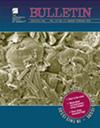冈底斯带古新世—始新世辉长岩的岩石成因:藏南地区洋俯冲向大陆碰撞岩浆作用过渡的地球化学示踪
IF 3.9
1区 地球科学
Q1 GEOSCIENCES, MULTIDISCIPLINARY
引用次数: 0
摘要
对控制冈底斯带(藏南)下熔体演化的印亚碰撞过程中弧下地幔的组成和地球动力学过程的模式和性质尚不清楚。本文对东冈底斯岩浆带古新世—始新世纳金拉辉长岩进行了锆石U-Pb年龄、Hf同位素、全岩地球化学和Sr-Nd-Pb同位素的研究,旨在追踪该地区由洋俯冲到大陆碰撞形成的过渡性岩浆活动。锆石U-Pb分析结果表明,这些基性岩石的侵位年龄分别为54±1 Ma和63±1 Ma。辉长岩的特征是SiO2 (45.87 ~ 55.44 wt%)、MgO (1.03 ~ 8.18 wt%)、FeOT (3.74 ~ 12.33 wt%)和Al2O3 (13.45 ~ 25.45 wt%)含量变化较大。大多数样品表现出高Al2O3 (17.15 ~ 25.45 wt%)和相对低MgO (1.03 ~ 6.11 wt%),与典型的高铝玄武岩和高铝玄武岩安山岩相似。纳金拉辉长岩具有明显的俯冲特征,大离子亲石元素富集,高场强元素富集。它们的Sr-Nd同位素组成较低且相对均匀,初始87Sr/86Sr同位素比值为0.7045 ~ 0.7049,εNd(t)比值为+2.2 ~ +3.2。那金拉辉长岩的锆石εHf(t)值为正,范围为+5.6 ~ +10.9。这些结果共同表明辉长岩岩浆是由软流圈部分熔融形成的,在其侵位过程中地壳污染可以忽略不计。认为纳金拉辉长岩的地幔源受到地幔楔中俯冲的新特提斯洋壳源流体的强烈影响和交代作用。始新世早期新特提斯板块的俯冲回退导致了俯冲修正地幔的部分熔融,形成了辉长岩。本文章由计算机程序翻译,如有差异,请以英文原文为准。
Petrogenesis of Paleocene−Eocene gabbros in the Gangdese belt: Geochemical tracking of transitioning from oceanic subduction to continental collision related magmatism in southern Tibet
The composition of the sub-arc mantle and the mode and nature of geodynamic processes during the India-Asia collision that controlled the melt evolution beneath the Gangdese belt (southern Tibet) are still unclear. Here, we present new U-Pb ages and Hf isotopes of zircon, and whole-rock geochemical and Sr-Nd-Pb isotopic data of the Paleocene−Eocene Najinla gabbros from the East Gangdese magmatic belt, aiming to track the transitioning magmatism formed from oceanic subduction to continental collision in the region. Zircon U-Pb analyses of these mafic rocks yield emplacement ages of 54 ± 1 Ma and 63 ± 1 Ma. The gabbros are characterized by variable SiO2 (45.87−55.44 wt%), MgO (1.03−8.18 wt%), FeOT (3.74−12.33 wt%), and Al2O3 (13.45−25.45 wt%) contents. Most samples exhibit high Al2O3 (17.15−25.45 wt%) and relatively low MgO (1.03−6.11 wt%), similar to typical high-alumina basalts and high-alumina basaltic andesites. The Najinla gabbros show characteristic subduction-related signatures with enriched large-ion lithophile elements and depleted high field strength elements. They have depleted Sr-Nd isotopic compositions with low and relatively homogeneous initial 87Sr/86Sr isotopic ratios of 0.7045−0.7049 and positive εNd(t) ratios of +2.2 to +3.2. The Najinla gabbroic rocks also have positive zircon εHf(t) values, ranging from +5.6 to +10.9. These results collectively suggest that magmas of the gabbros formed by partial melting of the asthenosphere with negligible crustal contamination during their emplacement. We propose that the mantle source of the Najinla gabbros was strongly influenced and metasomatized by subducted Neotethyan oceanic crust-derived fluids in the mantle wedge. Rollback of the subducted Neotethyan slab in the early Eocene led to partial melting of the subduction-modified mantle and the formation of these gabbros.
求助全文
通过发布文献求助,成功后即可免费获取论文全文。
去求助
来源期刊

Geological Society of America Bulletin
地学-地球科学综合
CiteScore
9.30
自引率
8.20%
发文量
159
审稿时长
4-8 weeks
期刊介绍:
The GSA Bulletin is the Society''s premier scholarly journal, published continuously since 1890. Its first editor was William John (WJ) McGee, who was responsible for establishing much of its original style and format. Fully refereed, each bimonthly issue includes 16-20 papers focusing on the most definitive, timely, and classic-style research in all earth-science disciplines. The Bulletin welcomes most contributions that are data-rich, mature studies of broad interest (i.e., of interest to more than one sub-discipline of earth science) and of lasting, archival quality. These include (but are not limited to) studies related to tectonics, structural geology, geochemistry, geophysics, hydrogeology, marine geology, paleoclimatology, planetary geology, quaternary geology/geomorphology, sedimentary geology, stratigraphy, and volcanology. The journal is committed to further developing both the scope of its content and its international profile so that it publishes the most current earth science research that will be of wide interest to geoscientists.
 求助内容:
求助内容: 应助结果提醒方式:
应助结果提醒方式:


